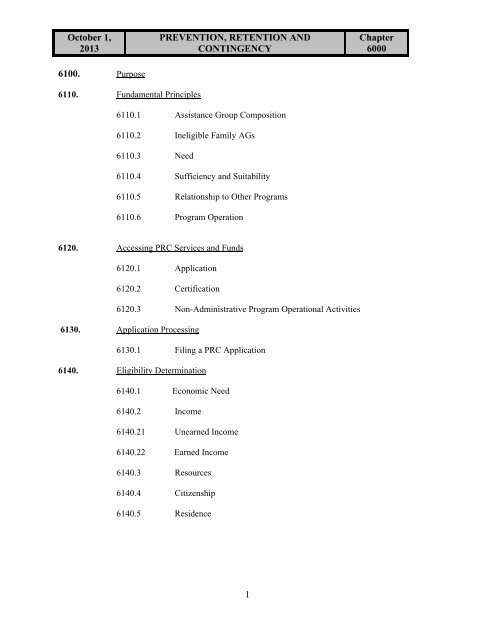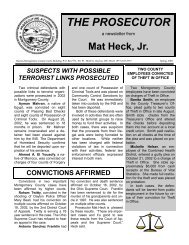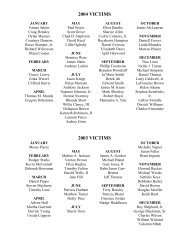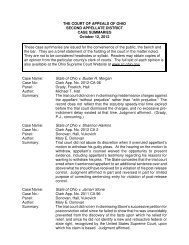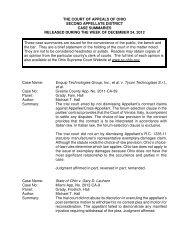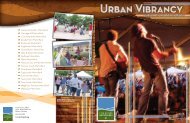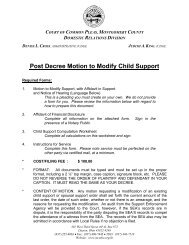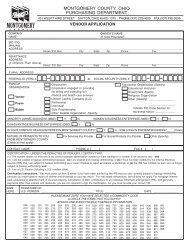PRC Policy - Montgomery County, Ohio
PRC Policy - Montgomery County, Ohio
PRC Policy - Montgomery County, Ohio
You also want an ePaper? Increase the reach of your titles
YUMPU automatically turns print PDFs into web optimized ePapers that Google loves.
October 1,2013PREVENTION, RETENTION ANDCONTINGENCYChapter60006100. Purpose6110. Fundamental Principles6110.1 Assistance Group Composition6110.2 Ineligible Family AGs6110.3 Need6110.4 Sufficiency and Suitability6110.5 Relationship to Other Programs6110.6 Program Operation6120. Accessing <strong>PRC</strong> Services and Funds6120.1 Application6120.2 Certification6120.3 Non-Administrative Program Operational Activities6130. Application Processing6130.1 Filing a <strong>PRC</strong> Application6140. Eligibility Determination6140.1 Economic Need6140.2 Income6140.21 Unearned Income6140.22 Earned Income6140.3 Resources6140.4 Citizenship6140.5 Residence1
October 1,2013PREVENTION, RETENTION ANDCONTINGENCYChapter60006150. Community Resources6150.1 Exploring Community Resources6150.2 HEAP6160. Program Integrity and Control6160.1 Approval Process6160.2 Record Retention6160.3 CRIS-E6160.4 Scope of Benefits/ServicesAppendix I - Federal Poverty Guidelines, List of Services and BenefitsAppendix II - Assistance Group Composition GuideAppendix III - Applications, Notices and Agreements2
October 1,2013PREVENTION, RETENTION ANDCONTINGENCYChapter6000MONTGOMERY COUNTY PREVENTION RETENTION CONTINGENCY (<strong>PRC</strong>) PROGRAM6100: PurposeThe Prevention, Retention, and Contingency (<strong>PRC</strong>) Program is designed to provide benefits and servicesto needy families and low-income employed families who are in need of help with essential supports tomove out of poverty and become self-sufficient. These supports include non-recurrent, short-term, crisisorientedbenefits and ongoing services that are directly related to the four purposes of the TANF programwhich do not meet the federal definition of assistance. The four purposes of TANF are:1. To provide assistance to needy families so that children may be cared for in their own home orin the home of a relative; This purpose covers only needy families so children may live with theirparents, relatives, legal guardians, or legal custodians. It does not cover children living with nonrelatives.A needy family is one that meets the income and/or resource standards established bythe state in its TANF plan. A state may establish a variety of income and resource standards for“assistance” and other services and benefits.2. End the dependence of needy parents on government benefits by promoting job preparation,work, and marriage; Help any needy parent, including a non-custodial parent or a working parentby providing employment, job preparation or training services designed to increase the noncustodialparent’s ability to pay child support3. Prevent and reduce the incidence of out-of-wedlock pregnancies and establish annualnumerical goals for preventing and reducing the incidence of these pregnancies; which is notlimited to needy families or individuals. Potential activities that would accomplish this purposeinclude family planning clinical and follow-up services, abstinence programs, visiting nurseservices and programs and services for youth such as counseling, teen pregnancy, preventioncampaigns and after-school programs.4. Encourage the formation and maintenance of two-parent families. A significant share of TANFfamilies consists of unmarried mothers with low skills who live with their children apart fromlow-skilled, underemployed fathers. Many of these fathers are involved in the lives of theirchildren and provide some financial support, but would like to do much more. This purposemight include parenting skills training, premarital and marriage counseling, and mediationservices; activities to promote parental access and supervision; job placement and trainingservices for non-custodial parents; initiatives to promote responsible fatherhood and increase thecapacity of fathers to provide emotional and financial support for their children; and crisis orintervention services.Non-recurrent, short-term assistance addresses discreet crisis situations which do not provide for needsextending beyond four months. These non-recurrent benefits and services may encompass more than onepayment a year, as long as the payment provides short-term relief and addresses a discreet crisis situationrather than meeting ongoing or recurrent needs. These benefits and services are consistent with thefederal definition of non-assistance as found in Code of Federal Regulations ( C.F.R.) 260.31 (b). Thedefinition of non-assistance includes:1. Non-recurrent, short-term benefits that:a. are designed to deal with a specific crisis situation or episode of need;b. are not intended to meet recurrent or ongoing needs; andc. will not extend beyond four months;3
October 1,2013PREVENTION, RETENTION ANDCONTINGENCYChapter60002. Work subsidies (i.e., payments to employers or third parties to help cover the costs of employerwages, benefits, supervision, and training);3. Supportive services such as time limited drop-off child care and transportation provided tofamilies who are employed;4. Contributions to and distributions from Individual Development Accounts;5. Refundable earned income tax credits;6. Services such as counseling, case management, peer support, child welfare services, child careinformation and referral, transitional services, job retention, job advancement, and otheremployment related services that do not provide basic income support; andSpecific benefits and services provided by this plan are contained in Appendix I.6110: Fundamental Principles6110.1: Assistance Group Composition<strong>PRC</strong> benefits and services are available to a family assistance group (AG) which includes a minorchild or pregnant individual as defined in Sections 5108.01, 5108.06, and 5107.02 of the revisedcode. <strong>PRC</strong> benefits and services are also available to the non-custodial parent of a minor child.The non-custodial parent must live in the county but does not live in the same household as theminor child and who establish or who are in the process of establishing responsibility for theirchild(ren) through the CSEA. Documentation is required.Except for services targeted to meet TANF goals 3 and 4, an eligible AG must consist of a minorchild who resides with a parent, caretaker relative, legal guardian, or legal custodian or consist ofa pregnant individual.A child may be temporarily absent from the home in accordance with the time frames establishedin rule 5101:1-3-04 of the <strong>Ohio</strong> Administrative Code (OWF definition of temporary absence,child welfare-protective services) and still qualify for <strong>PRC</strong>. During the temporary period, thechild is considered to be residing with the parent, caretaker relative, legal guardian, or legalcustodian. An eligible family may also consist of a minor child residing with a parent, caretakerrelative, legal guardian, or legal custodian and other family members of the household (who mayor may not be related to the minor child) who may significantly enhance the family’s ability toachieve economic self-sufficiency. (See Appendix II Assistance Group Composition Guide.)6110.2 Ineligible Family AGsFederal and State law must be adhered to when providing <strong>PRC</strong> benefits and services. Listedbelow are federal and state prohibitions based upon 42 U.S.C.608, section 431 of PRWORA (asamended by the Illegal Immigration Reform and Immigrant Responsibility Act of 1996 and theBalanced Budget Act of 1997) and the <strong>Ohio</strong> Revised Code:1: No assistance for families without a minor child, except for services provided to meet TANF4
October 1,2013PREVENTION, RETENTION ANDCONTINGENCYChapter6000goals 3 and 4.2: No assistance to a single individual, unless such individual is pregnant.3: No benefits or services to an individual who is not a citizen of the United States or a qualifiedalien as defined in rule 5101:1-2-30 (A) (2) of the <strong>Ohio</strong> Administrative Code.4: No assistance for families that fraudulently receive assistance under the OWF and <strong>PRC</strong>programs until repayment occurs. Ref. 5101.83 of the ORC6110.3 NeedEligibility for <strong>PRC</strong> is dependent upon the AG’s demonstration of need for services and benefits.The applicant must cooperate in securing verification of all eligibility factors when applying forservices and benefits which provide a direct financial benefit. A modified declaration method ofeligibility determination that includes dictation documenting all eligibility factors may be used todetermine eligibility for families applying for services and benefits which do not provide a directfinancial benefit. Use of the modified declaration method of eligibility determination is limited tocontracted services and benefits.Families not in receipt of benefits under a Federal need-based program must meet the economicneed standard for the benefit/service requested. The economic need standards are based uponfederal poverty guideline measures which shall be updated annually, generally in March, whenthe federal poverty guidelines are released. When determining income eligibility for the <strong>PRC</strong> AGto receive benefits or services, the AG income must be equal to or less than the economic needstandard. (List of Services and Benefits, Appendix I )6110.4 Sufficiency and Suitability<strong>PRC</strong> contingency benefits will be authorized with the expectation that the <strong>PRC</strong> AG will be able tofunction without additional agency help. Services and benefits shall be provided which directlylead to or can be expected to lead the family in becoming self-sufficient by accomplishing one ofthe four purposes of TANF as referenced in 6110.1:There are basic minimum educational standards for participation in training or educationprograms. The Job and Family Services Specialist inform the applicant that they must take acomprehensive assessment and testing with a MCDJFS WIA approved vendor to determine theirfunctional educational level. After the results from the comprehensive assessment and testingthe applicant must consult with the Workforce Investment Act (WIA) Unit to determine theirsuitability for training and/or education. Results of WIA’s determination of suitability for trainingand/or education will dictate the approval/denial of the <strong>PRC</strong> application by the Job and FamilyServices Specialist.6110.5: Relationship to Other ProgramsReceipt of assistance from programs such as <strong>Ohio</strong> Works First (OWF), Disability FinancialAssistance (DFA), and entitlement programs such as Medicaid and Food Assistance does notpreclude eligibility for receipt of benefits and services within the <strong>PRC</strong> program. MCDJFS willensure that applicants and recipients of <strong>PRC</strong> who may not already be receiving assistance receiveappropriate information about referrals to, and access to Medicaid, Food Assistance, Child Care,and other programs that provide benefits that could help them successfully make the transition to5
October 1,2013PREVENTION, RETENTION ANDCONTINGENCYChapter6000work.6110.6: Program OperationTo ensure fair and equitable treatment of families applying for <strong>PRC</strong>, the program shall becontinuously in operation according to the standards of policy and procedure as set forth withinthis chapter as long as <strong>PRC</strong> funds remain available. The covered benefits or services or theamounts specified for the benefits and services listed in Appendix I detailing the scope ofcoverage may not be reduced, limited, or restricted unless the program is amended. Programtermination due to lack of <strong>PRC</strong> funds will occur immediately and without prior notice.6120: Accessing <strong>PRC</strong> Services and FundsPursuant to Chapter 3 of the <strong>PRC</strong> reference guide, <strong>PRC</strong> services and benefits can only beaccessed through MCDJFS by one of the following methods:6120.1: ApplicationAn application is required to determine eligibility for <strong>PRC</strong> funds connected to any service orbenefit that has a financial need eligibility requirement. This includes all benefits, services, andprograms targeted to meet TANF goals 1 and 2.6120.2: CertificationAn application is not required to determine eligibility for <strong>PRC</strong> funds connected to a service orbenefit, defined in Appendix I, to not have a financial need eligibility requirement. Thesebenefits, services, and programs can only be targeted to meet TANF goals 3 and 4, and mustadhere to guidelines set forth in the contract with the specified agency.6120.3: Non-Administrative Program Operational ActivitiesCertain benefits and services do not require an application for assistance as they do not provide adirect service linked to an individual family. These benefits and services must fall under theclassification of non-administrative program operation costs and must be in accordance with thecontract of the specified agency. Such activities may include but are not limited to employerrecruitment, information and referral, public service announcements and Community andEconomic Development initiatives.6130: Application Processing6130.1: Filing a <strong>PRC</strong> ApplicationThe applicant must complete, sign, and date a <strong>PRC</strong> application. The form MCDJFS 9630-D willbe used by individuals applying for <strong>PRC</strong> benefits and services with MCDJFS at the Job Center.MCDJFS also contracts with several organizations to provide benefits and services to familiesunder the <strong>PRC</strong> program. These contractors will secure a signed MCDJFS 9633 application andany required documentation. MCDJFS will use objective criteria to determine <strong>PRC</strong> eligibility. At6
October 1,2013PREVENTION, RETENTION ANDCONTINGENCYChapter6000Veterans Administration BenefitsCompensation BenefitsUnemployment BenefitsPension and Retirement BenefitsOWF, DFA or Supplemental Security Income WorkersLump-sum payments (including tax refunds)Strike Benefits6140.22: Earned IncomeEarned income is income in which the AG member must perform some type of labor or service toreceive it. The following are examples of earned income. This is not intended to be an allinclusivelist:Earnings from work as an employeeEarnings from self-employment, less the cost of doing businessStrike benefits if the striker is required to perform services in order to receive themTraining allowance6140.3: ResourcesApplicants must use all available resources in excess of $250.00 to meet the contingent need.Excess personal resources shall be combined with <strong>PRC</strong> to meet the contingent need. Examples ofavailable resources include, but are not limited to:Cash on handDemand deposits accountsStocks, bonds and saving bondsAvailability of personal resources does not preclude the use of <strong>PRC</strong> to meet the applicant’s needfor benefits or services. Personal resources are not a factor when the service or benefit does notprovide a direct financial benefit.6140.4: CitizenshipIn order to receive <strong>PRC</strong> benefits and services, a member of the AG must be a citizen of theUnited States or a qualified alien as defined in Section 5506 (d) of Public Law 105-33 (theBalanced Budget Act of 1997). Reference <strong>Ohio</strong> Administrative Code 5101:1-2-30.Documentation of citizenship or alien status is required.6140.5: Residence<strong>PRC</strong> benefits and services are available to residents of <strong>Montgomery</strong> <strong>County</strong>. Residence isestablished by living in the county voluntarily with the intent to remain permanently or for anindefinite period of time. Residence is also established by an applicant who is not receivingassistance from another county and entered the county with a job commitment or seekingemployment, whether or not currently employed. Documentation of residence is required.6150: Community Resources6150.1: Exploring Community ResourcesThe availability of resources within the local community shall be explored prior to theauthorization of <strong>PRC</strong>. A <strong>PRC</strong> AG shall apply for and utilize any program, benefit, or support8
October 1,2013PREVENTION, RETENTION ANDCONTINGENCYChapter6000system which may reduce or eliminate the presenting need.6150.1: Exploring Community Resources (Continued)Personnel authorizing <strong>PRC</strong> should be aware of any community resources that could assist afamily in need of immediate services. The knowledge of those resources that are available isnecessary to determine if any other means within the community may meet or help meet thepresenting needs. Local contracts with other entities may be initiated to provide services whichmay meet or help meet requested needs (i.e., planning transportation services). The <strong>PRC</strong>application provides a section for written documentation of agency attempts to locate and utilizeresources within the community.6150.2: HEAP<strong>PRC</strong> may not be authorized to prevent shut-off or restore utility service when HEAP is available.6160: Program Integrity and Control6160.1: Approval ProcessThe approval of the Director or designee is required to authorize <strong>PRC</strong> assistance. The Job andFamily Services Specialist shall investigate the circumstance presented on the application; securesufficient verification and documentation to support the eligibility decision, and either deny theapplication for <strong>PRC</strong> or make a recommendation of approval to the unit supervisor. The unitsupervisor will review the application and supporting verification/documentation. If thesupervisor concurs with the recommendation to approve, the application package shall beforwarded to the Director or designee for a final evaluation. The Director or designee mayconcur with the decision to approve <strong>PRC</strong> or overrule the recommendation.Note: Once a customer has been approved for <strong>PRC</strong> supportive services, any changes in his or hercircumstances will not affect eligibility for the approved services.MCDJFS reserves the right to deny <strong>PRC</strong> services to any applicant who has demonstrated apattern of <strong>PRC</strong> misuse or abuse (actual or attempted). An application for <strong>PRC</strong> can also be deniedfor failure to meet the eligibility requirements, failure to cooperate and failure to verifyemployment. Submitting fraudulent documentation or failure to provide information needed todetermine eligibility within (30) days of completing the application can result in a denial decisionbeing made. All <strong>PRC</strong> overpayments shall be subject to the same rules and regulations as TANFoverpayments as outlined in OAC 5101:1-23-70.The focus of the <strong>PRC</strong> program is to provide and authorize benefits and services within a specificdate of the receipt of a signed application which is 30 days. A ten-day standard of promptness is asuggested time frame that is intended to stress the importance of dealing with <strong>PRC</strong> application inan efficient manner. Of course, some emergencies may warrant a speedier disposition such as autility shutoff or other emergency. In some instances, this time frame will not be met due tounavoidable delays on the part of the applicant or the agency<strong>PRC</strong> notices must be in compliance with Chapter 5101:6 of the <strong>Ohio</strong> AdministrativeCode. Rules 5101:6-2-02 and 5101:6-2-03 of the <strong>Ohio</strong> Administrative Code set forth therequirements for issuing notice when an application for public assistance benefits including9
October 1,2013PREVENTION, RETENTION ANDCONTINGENCYChapter6000assistance under the <strong>PRC</strong> program, is approved or denied.The applicant must have the opportunity to be heard in a state hearing or an administrativeappeal. Pursuant to Section 5108.09 of the <strong>Ohio</strong> Revised Code, A <strong>PRC</strong> hearing decision is basedupon the <strong>PRC</strong> program plan in effect at the time of the adverse decision, and the countydepartment must provide a copy of the statement of policies and all amendments to the hearingofficer.6160.2: Records RetentionThe application and any other information gathered during the eligibility determination processshall be kept in the ongoing OWF, Medicaid, and/or Food Assistance AG record. If the AG is notin receipt of ongoing OWF, Medicaid, and/or Food Assistance, a separate AG record should bemaintained for the <strong>PRC</strong> application and related verifications. In addition, <strong>PRC</strong> benefits andservices provided to non-custodial parents shall also be kept in a separate AG record.Note: If a CDJFS contracts with a provider for issuance of benefits and services under the <strong>PRC</strong>program, the application responsibilities should be clearly addressed within the contractagreement. All <strong>PRC</strong> case documentation from the provider should be readily available forauditing purposes.6160.3: CRIS-EMCDJFS shall use the CRIS-E computer system to track <strong>PRC</strong> benefits and services received fromcounty to county through the statewide clearance process. The CRIS-E application entry(ARAD) shall be used to register the AG, and the <strong>PRC</strong> driver (AEOEA) will record the manualissuance of benefits and services. MCDJFS shall assign sufficient staff to accomplish this goal.All <strong>PRC</strong> payments shall be made to a vendor according to the normal payment procedures andschedules in place at MCDJFS.Note: <strong>PRC</strong> services such as those provided by Family and Children First’s Early Start program,the School Readiness program, and such other services as the <strong>Ohio</strong> Department of Job and FamilyServices (ODJFS) may allow will be tracked and recorded through the ODHS 2827, MonthlyFinancial Statement.6160.4: Scope of Benefits/ServicesThe attached chart, List of Services and Benefits, Appendix I, contains the scope of benefits andservices provided under the MCDJFS <strong>PRC</strong> program. The chart also contains the assistancegroups served, the economic need standards for the particular benefit/service, caps onbenefits/services, and the targeted groups. The targeted groups are used to customize servicedelivery specific to the family’s circumstances. The MCDJFS 223 must be completed forapplicants who have an ADC/OWF overpayment. Background check, verification of insurance,and operators’ license are required for auto repair. Receipt of <strong>PRC</strong> benefits and services fromanother county count against the cap for services or benefits in <strong>Montgomery</strong> <strong>County</strong>. Job andFamily Services Specialists shall not determine eligibility for contracted or <strong>PRC</strong>-DR servicesunless specifically authorized to do so.The <strong>Montgomery</strong> <strong>County</strong> Department of Job and Family Services agrees to implement the10
October 1,2013PREVENTION, RETENTION ANDCONTINGENCYChapter6000Prevention, Retention and Contingency plan as provided for in this document effective October 1,2013.________________________________________________________________________Gayle Bullard, Director of <strong>Montgomery</strong> <strong>County</strong>DateDepartment of Job and Family Servicesor Designee11
October 1,2013PREVENTION, RETENTION ANDCONTINGENCYChapter6000APPENDIX IList of Services and Benefits12
APPENDIX IIAssistance GroupsIn <strong>Ohio</strong>, all families are served through defined assistance groups. Assistance groups participating in theOWF program are defined differently from those obtaining services under the <strong>PRC</strong> program. The OWFassistance group is established by administering rule and, generally, is more restrictive than <strong>PRC</strong> in termsof who may be included in the assistance group. The logic for creating an OWF assistance group isdefined within the CRIS-E System. Generally, a person can only be in one assistance group to receiveOWF assistance payments. A county may serve OWF assistance groups that overlap with <strong>PRC</strong> assistancegroups.Assistance Group Composition<strong>PRC</strong> benefits and services for purposes 1 and 2 of TANF are available to a family assistance group whichincludes a minor child or pregnant individual as defined in ORC 5108.01 and 5108.06. <strong>PRC</strong> benefits andservices are also available to the non-custodial parent of a minor child who lives in the county but doesnot live in the same household of the minor child. Counties can opt to provide <strong>PRC</strong> benefits and servicesto a non-custodial parent of a minor child who lives in the state.At a minimum, an eligible family must consist of a minor child who resides with a parent, caretakerrelative, legal guardian or legal custodian (or consist of a pregnant individual). No family is eligible for<strong>PRC</strong> benefits and services unless the family includes a minor child who resides with the parent, caretakerrelative, legal guardian or legal custodian. <strong>PRC</strong> benefits and services may also be provided to a pregnantindividual with no other minor children.A child may be “temporarily absent” from the home in accordance with the time frames established inOAC 5101:1-3-04 and still qualify for <strong>PRC</strong>. During the temporary period, the child is considered to beresiding with the parent, caretaker relative, legal guardian or legal custodian. An eligible family may alsoconsist of a minor child residing with a parent, caretaker relative, legal guardian or legal custodian andother members of the household (who may or may not be related to the minor child) who maysignificantly enhance the family’s ability to achieve economic self-sufficiency.The exception to the above assistance group composition requirement is that for purpose 3 of TANF,pregnancy prevention services will be available to families with children as well as to childlessindividuals. As already discussed, neither purpose 3 nor purpose 4 is limited to needy families orindividuals. A county could use federal TANF funds (but not MOE), under <strong>PRC</strong> to serve non-needyfamilies or individuals for either of these two purposes.The assistance group composition for a specific benefit or service is reflected in the chart. “State Model:List of Services & Benefits.” found in Appendix A. All of the benefits and services in the chart are meantto meet purposes 1 and 2 of TANF, with the exception of pregnancy prevention services which areprovided to meet purpose 3 of TANF.<strong>County</strong> agencies may create several categories of <strong>PRC</strong> assistance groups to receive different benefits andservices. <strong>County</strong> agencies may create <strong>PRC</strong> assistance groups so that benefits, services and expenditurelimits are applied differently to different <strong>PRC</strong> assistance groups. In addition, a child can be connected tomore than one assistance group receiving <strong>PRC</strong>.Below are examples of multiple assistance groups and discussion of county options in creating andserving <strong>PRC</strong> assistance groups. The examples include overlapping <strong>PRC</strong> and OWF assistance groups.These examples are designed to convey various scenarios of multiple assistance groups but do not exhaustall the potential arrangements.
Applications, Notices and AgreementsAPPENDIX III


